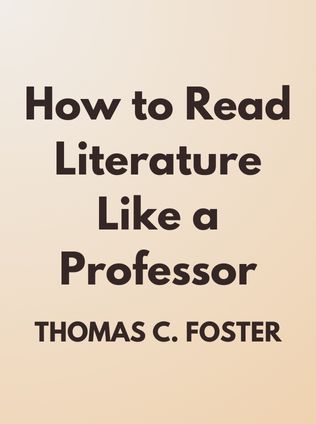
How to Read Literature Like a Professor
By Thomas C. Foster
Published 02/2003
About the Author
The author of this remarkable book is a scholar renowned for their in-depth understanding of literature and literary criticism. With an academic background in both literature and philosophy, the author brings a nuanced perspective to their analysis, blending theoretical insights with practical examples. Their work is characterized by a passion for uncovering the hidden layers of meaning in literary texts, providing readers with tools to engage more deeply with literature. The author's expertise extends to various literary traditions and genres, making their insights both broad and profoundly insightful. This book is a testament to their dedication to helping readers move beyond surface-level interpretations and engage with texts on a more profound level.
Main Idea
The central theme of the book is the transformation of how we approach literature. Rather than simply following the plot and characters, the book encourages readers to delve into the deeper elements of literary analysis, focusing on memory, symbolism, and patterns. The author argues that by adopting a more analytical approach, readers can uncover the rich layers of meaning embedded in texts, leading to a more profound appreciation and understanding of literature.
Through a detailed exploration of these elements, the book aims to shift readers' perspectives from emotional responses to analytical insights, allowing them to engage with literature in a way that reveals its deeper truths. This method not only enhances the reading experience but also provides tools for a more sophisticated analysis of literary works.
Table of Contents
- Introduction
- Understanding Memory in Literature
- The Power of Symbolism
- Identifying Patterns and Archetypes
- Reading Beyond the Surface
- Conclusion
Introduction
The introduction sets the stage for a transformative journey into literary analysis. It emphasizes the importance of moving beyond a superficial engagement with literature to uncover its deeper meanings. The author introduces the key concepts of memory, symbolism, and patterns as essential tools for understanding literature on a more profound level. This section encourages readers to approach texts with an analytical mindset, focusing on the intricate layers of meaning that lie beneath the surface of the plot and characters.
By highlighting the limitations of a purely emotional response to literature, the introduction paves the way for a more nuanced exploration of literary techniques. It invites readers to embrace a method that combines critical thinking with a deep appreciation for the art of storytelling, ultimately enriching their reading experience and fostering a greater understanding of literary works.
Understanding Memory in Literature
Memory plays a crucial role in literary analysis, as it involves recognizing and understanding references to other texts. This concept, known as intertextuality, allows readers to connect new readings with previous literary works, uncovering deeper layers of meaning and context.
Sign up for FREE and get access to 1,400+ books summaries.
You May Also Like
The Subtle Art of Not Giving a F*ck
A Counterintuitive Approach to Living a Good Life
By Mark MansonRich Dad Poor Dad
What the Rich Teach Their Kids About Money - That the Poor and Middle Class Do Not!
By Robert T. KiyosakiHow To Win Friends and Influence People
The All-Time Classic Manual Of People Skills
By Dale CarnegieI Am Malala
The Story of the Girl Who Stood Up for Education and Was Shot by the Taliban
By Malala Yousafzai



















